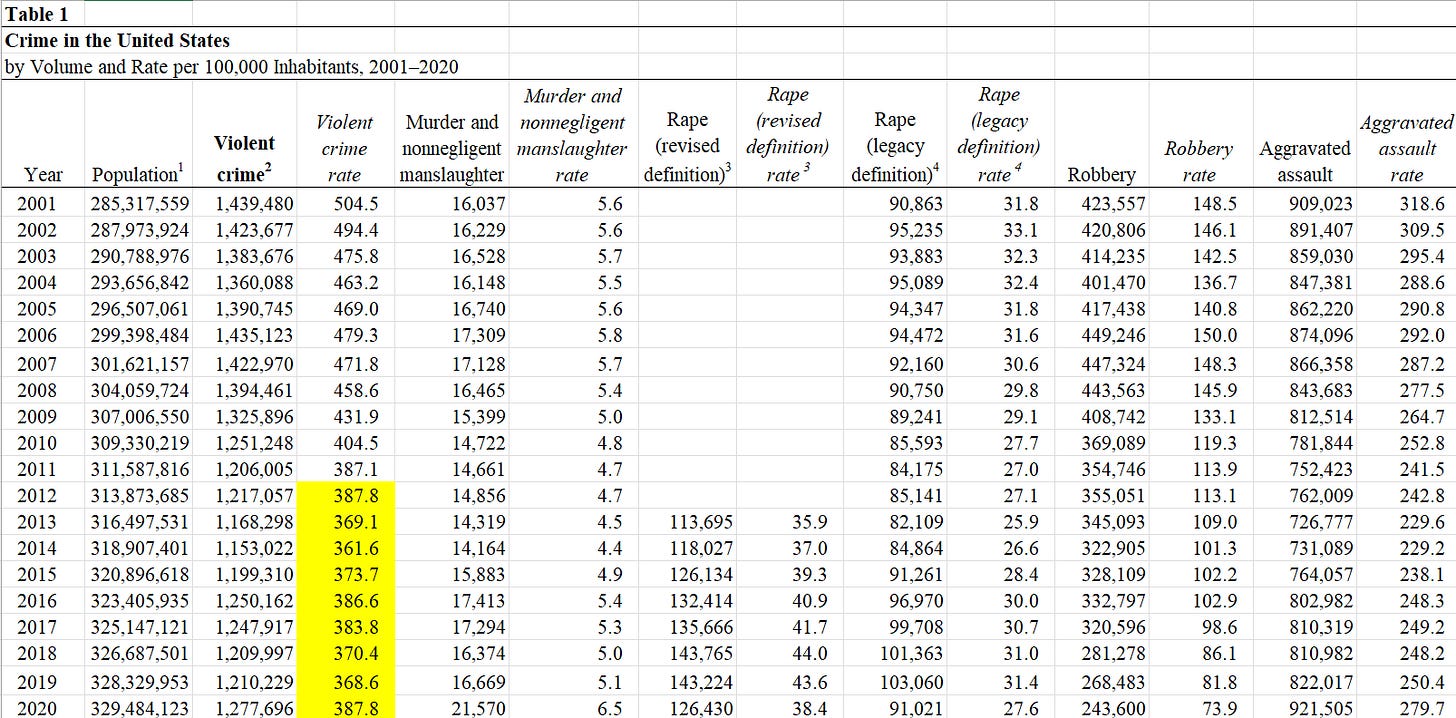Let’s say we’re talking about the murder rate nationally and I want to give a historical comparison. To do that we need data from 1960 to present which sounds simple but is actually quite challenging.
The FBI began publishing UCR Part I national estimates in 1960, but the FBI only has national estimates available back to 1979 on the Crime Data Explorer. The older FBI reports (including reports back to 1930 which didn’t have national estimates) can be found in scanned PDF form, but figuring out national estimates for each year requires a ton of manual labor.
There used to be a workaround in the form of a handy website called UCRDataTool.gov which was hosted by the FBI. This simple site let you download data by agency, statewide, and nationally for every UCR Part I offense.
Sadly it was decommissioned to make way for the CDE. But before it was I downloaded crime counts and rates for every UCR Part I offense going back to 1960 and am now presenting that data in the below downloadable graphs.
One note: I’m using the FBI’s Crime in the US 2022 Table 1 for crime counts and rates from 2003 to 2022 which gives counts and rates for every major crime for the last 20 years. This table differs slightly from data on the CDE’s crime trend graph for two very in-the-weeds reasons which you can gloss over unless you’re interested in the inner workings of crime data (which I assume you are otherwise why would you be here?).
First, the FBI always updates the most recent previous year of data when it publishes data on the current year to reflect new data that has been received. So when they published 2019’s estimates in October 2020 they slightly altered 2018’s. The changes are usually pretty minor. With the 2022 data, however, the FBI slightly edited crime counts for every year from 2003 to 2022 (the years covered in Table 1).
Here’s how Table 1 looked like for 2020 when published:
And here is the table released for 2022:
The counts are tot hugely different but it's worth noting that they aren’t identical.
Second, if you run the violent crime rate nationally on the CDE’s trends tool going back a ways you’ll notice that the violent crime rate on the CDE matches what’s in Table 1 for 2020 all the way up to 2015 but then they diverge (the highlighted parts above). Table 1 for 2020 shows a violent crime rate of 373.7 for 2015 and 386.6 for 2016, but the CDE shows a violent crime rate of 373.7 for 2015 and 397.5 for 2016.
The difference is entirely due to a definitional change to rape that the FBI made in 2013 but for some reason only began counting it in 2016. The definitional change is good, but you’ll notice on the above charts that the violent crime rate column uses what’s called the legacy definition which makes comparisons between the years apples-to-apples all the way back to 1960.
On CDE though the violent crime rate switches to the revised definition which adds a bit over 10 crimes per 100k per year to the total and makes a reasonably smooth line look like a fairly large increase beginning in 2016. The violent crime rate in 2022, for example, matches what you’d get using the revised definition of rape…
While 2015’s matches the legacy definition of rape from Table 1 for 2020 (but oddly not Table 1 for 2022).
All of which is to say that for consistency sake I am using Table 1 for 2022’s data to cover 2003 to 2022 and 1960 to 2002 from the old UCRDataTool.gov website. That gives us an apples-to-apples comparison all the way from 1960 to 2022.
Smash the ‘Get The Data’ button to download to your heart’s content and tell your friends who may want more than 60 years of national crime estimates.








Hi Jeff,
The "Rates" button on the graphs gives me this error from Datawrapper:
404 Not Found
Code: NoSuchKey
Message: The specified key does not exist.
Key: CdII9/7/index.html
RequestId: E525MCJZF0K2FDAG
HostId: tXPrdNwWqy6EbCGwkkdMWIP+t6M5z1j0uTLbM3PcvkDp3ooXddZJzB+MS+O6KYfLY6TsDJ0fADM=
Hi Jeff: Interesting. Thanks.
When I left law enforcement and went to college decades ago, my criminological professors stated that western industrial nations had similar crime counts that were different, but essentially mimicked growth or declines in US crime rates or totals (over time) leading to a hypothesis that crime (and the forces contributing to crime) were not unique to the US but were international in nature.
I find it interesting that Canadian or UK or Australian crime forums often mimic (to a degree) what's happening in the US with obvious differences for firearms (knife crime in the UK is a big issue). But cops leaving or bail reform or fear of crime or gangs or immigration or violence all seem to be of importance in countries many thousands of miles apart. When I read Canadian articles or papers, I could easily be reading the same report for any US city.
It would be interesting (but laborious) to confirm this. Are the conditions that cause crime universal? Obviously poverty or income disparities play a basic role in criminology regardless as to where you live but the message of my professors was that what influences crime here influences crime trends throughout the industrialized western world.
Are we all one big criminological family when it comes to crime rates and total trends? Back in the day, criminologists seemed to believe that we were.
Len.